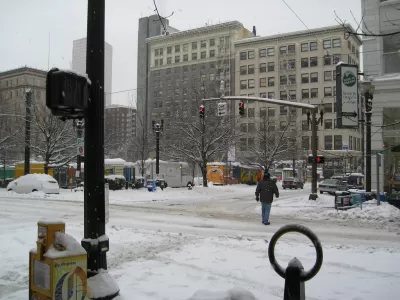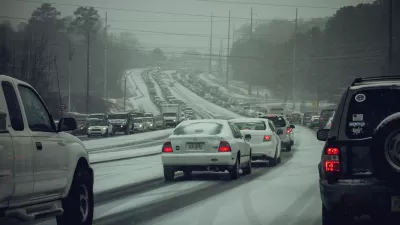Following in the footsteps of the "snowmageddon" events experienced by Atlanta in January 2014, Portland, Oregon had a surprising amount of difficulty with a small amount of snow this week.

Gillian Flaccus of the Associated Press shares news of the effects of a rare snowstorm in Portland, Oregon on Wednesday, December 14, 2016. The local story made the national news for its depiction of a crippled commute, abandoned cars, and closed schools.
Picking up the news for Bike Portland, Jonathan Maus contributed a critical perspective about why the day went so wrong.
Here’s the inconvenient truth: Our over-reliance on single-occupancy motor vehicle use has real consequences. It leads to lots of injuries and deaths, it poisons our lungs, and it makes our transportation system extremely fragile and inefficient.
To further that point, Maus shared an infographic illustrating the "Hierarchy of Mobility Resiliency." At the top "Feet." At the bottom "Cars." Maus's argument comes as a response to an article by The Oregonian, neglecting Maus's point but laying the blame on these five causes:
- Portland doesn't salt roads.
- Motorists don't carry chains.
- Drivers aren't experienced in snowy conditions.
- Portland doesn't have many snow plows.
- Transit doesn't reach to many parts of the city.
Also writing for The Oregonian, Lizzy Acker found enough good humor to scour social media for snarky takes on the whole bad snow day.
While Portland's considering how this snow storm had such a crippling effect on the city, it might want to consider the example of Atlanta, which was shut down for several days in January 2014 by just a few inches of snow. The event, dubbed "snowmaggedon," was also described by many commentators as a result of auto dependency.
FULL STORY: Winter Storm Snarls Portland Traffic, Stranding Thousands

Study: Maui’s Plan to Convert Vacation Rentals to Long-Term Housing Could Cause Nearly $1 Billion Economic Loss
The plan would reduce visitor accommodation by 25,% resulting in 1,900 jobs lost.

North Texas Transit Leaders Tout Benefits of TOD for Growing Region
At a summit focused on transit-oriented development, policymakers discussed how North Texas’ expanded light rail system can serve as a tool for economic growth.

Why Should We Subsidize Public Transportation?
Many public transit agencies face financial stress due to rising costs, declining fare revenue, and declining subsidies. Transit advocates must provide a strong business case for increasing public transit funding.

How to Make US Trains Faster
Changes to boarding platforms and a switch to electric trains could improve U.S. passenger rail service without the added cost of high-speed rail.

Columbia’s Revitalized ‘Loop’ Is a Hub for Local Entrepreneurs
A focus on small businesses is helping a commercial corridor in Columbia, Missouri thrive.

Invasive Insect Threatens Minnesota’s Ash Forests
The Emerald Ash Borer is a rapidly spreading invasive pest threatening Minnesota’s ash trees, and homeowners are encouraged to plant diverse replacement species, avoid moving ash firewood, and monitor for signs of infestation.
Urban Design for Planners 1: Software Tools
This six-course series explores essential urban design concepts using open source software and equips planners with the tools they need to participate fully in the urban design process.
Planning for Universal Design
Learn the tools for implementing Universal Design in planning regulations.
City of Santa Clarita
Ascent Environmental
Institute for Housing and Urban Development Studies (IHS)
City of Grandview
Harvard GSD Executive Education
Toledo-Lucas County Plan Commissions
Salt Lake City
NYU Wagner Graduate School of Public Service



























